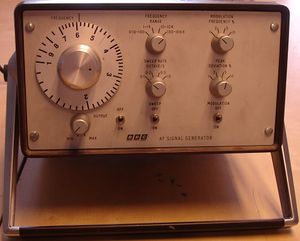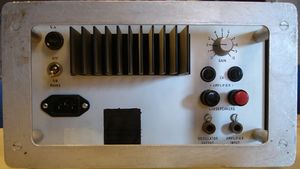Equipment/BBC AF signal generator
BBC AF signal generator
This belongs to Russ. You can use it but Russ will be grumpy if it gets damaged.
Quickstart To produce an audio tone: Connect a small loudspeaker to the binding posts at rear Select 100-100K range Frequency dial at 6 gives roughly middle C (720Hz). Gain knob on rear at 2 Front output knob up 20 degrees Sweep off Modulation off. Rear on/off switch on Front on/off switch on Tone should be heard in the loudspeaker.
Beware This unit has a built in amplifier. The loudspeaker terminals on the back can produce up to 40 volts peak to peak and a lot more current than a typical 600ohm signal generator output. You can blow up things like computer audio inputs!
Controls
Front panel
Frequency Control This is a three turn potentiometer, the markings on the dial bear little relationship to the output frequency but the control is smooth and noise free.
Frequency Range Four ranges, 0.1Hz-100Hz, 1Hz-1kHz, 10Hz-10kHz and 100Hz-100kHz.
Output Level Adjusts level at PO jack at rear and drive to amplifier.
Output On/Off
Sweep Rate Four sweep speeds, 0.1,0.2, 0.5 and 1 octave/sec.
Sweep On/Off Starts a single sweep from the current setting of the Frequency Control down the scale to the low frequency of the selected range. To initiate another sweep return the switch to Off and then On again.
Modulation Frequency % Four values, 1, 2, 5 and 10%
Peak Deviation % Four values, 1,2,5 and 10%
Modulation On/Off
Rear Panel
Mains Inlet (IEC)
Mains fuse (5amp
Mains On/Off
The low level audio output requires a quarter inch jack plug (it might need a PO316 plug, as used on studio patch bays, rather than a standard 1/4" jack). There isn't one handy with the unit.
It contains an ILP amplifier module. It my experience the overload protection on those would not protect it from all possible loads. It may be easier to blow up than a typical 600ohm signal generator output.
The 100-100K range seems most usefull, other ranges seem to be mostly below what little loudspeakers can produce.
The frequency dial is a bit wobbly and dosn't stop distinctly at the ends of it's travel. The variable resistor inside may not be in top mechanical condition.
History
This unit was made sometime around 1989 and looks like it was built from modules from the RS catalogue. Russ purchased it from an auction of old BBC equipment.
Log.
June 2011. Someone reported it not working, supposedly one of the fuses on the back was blown and blew again when replaced. The two fuses on the right hand of the rear panel supply +45volts and -45volts to the amplifier module. The +ve fuse was ok and is a 2amp T fuse. A 250mA fastblow fuse had been fitted in the other holder. Seems fine with a 2amp T fuse.

